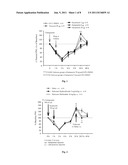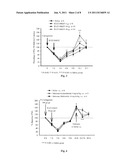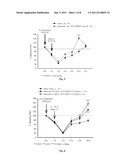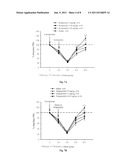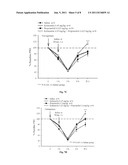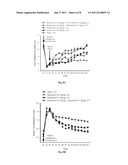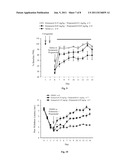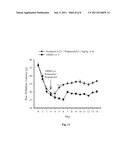Patent application title: COMBINATION OF TWO ANALGESIC CHEMICALS
Inventors:
Yanguo Hong (Fuzhou, CN)
IPC8 Class: AA61K31517FI
USPC Class:
51426622
Class name: Additional hetero ring attached directly or indirectly to the quinazoline ring system by nonionic bonding the additional hetero ring is six-membered consisting of one nitrogen and five carbons piperidinyl or tetrahydropyridyl
Publication date: 2011-06-09
Patent application number: 20110136839
Abstract:
The present invention is a novel analgesic combination and its use. It is
classified to he an invention in the field of medicine and technology.
The purpose of this invention is to solve the problem that existing
analgesics does not effectively attenuate pain or produces serious
side-effects in clinic. The ingredients of the analgesic combination
include ketanserin and propranolol. This combination is used to make a
drug to treat pain. Because the ingredients of the analgesic combination
target peripheral receptors, the unwanted effects could be only minimal.
The big advantage of this combination is that each of the ingredients
acts on the different receptors producing the synergizing analgesic.
Therefore, the analgesia that the combination produces is remarkable and
the effective doses are low.Claims:
1. A combination of two analgesic chemicals, wherein: the combination is
a mixture of ketanserin and propranolol.
2. The combination according to claim 1, is characterized by a defined mixture of ketanserin and propranolol with following proportions, Ketanserin: 50-70% by weight, Propranolol: 50-30% by weight. The two ingredients ketanserin and propranolol should be evenly mixed according to the above proportions to get the analgesic combination.
3. A combination of these two analgesic chemicals is used to alleviat pain according to claim 2.
4. The combination of the two analgesic chemicals is used to alleviate pain according to claim 3, wherein: this combination of two analgesic chemicals is dissolved in the injected vehicle to make an injected drug.
5. The combination of two analgesic Chemicals is used to alleviate pain according to claim 3. wherein: the combination of the two analgesic chemicals is dissolved in the injected water to make an injected drug.
6. The combination of two analgesic chemicals is used to alleviate pain according to claim 5, wherein: the injected drug comprising 1-50 mg of the combination of two analgesic chemicals is dissolved in 1 ml of injected water.
7. The Combination of two analgesic chemicals is used to alleviate pain according to claim 3, wherein: the pain that the combination can inhibit includes arthritic pain, muscleskeletal pain syndrome, general inflammatory pain, neuropathic pain and cancer pain.
Description:
BACKGROUND OF THE INVENTION
[0001] Pain is a protective mechanism warning that the body needs medical help. Actually at least half of patients see doctors because they suffer from pain. However, chronic pain does not display protective significance but seriously bothers people's life. Existing analgesics either are not very effective or produce serious adverse effects, or both. For example, opioids induce constipation and inhibit respiration. There is also an abuse potential with opiates, and the fear of dependence reduces compliance for this class of drugs. The COX-2 inhibitors family has been plagued by a number of adverse effects, some of which are even lethal. The old stand-by NSAIDs are also plagued by lethal serious adverse effects. Therefore, there is a competitive advantage in developing a drug that targets peripheral receptors because it would lacks CNS adverse effects.
[0002] It has been documented that many receptors in the periphery are involved in induction or modulation of pain, such as opioid (Hong & Abbott, 1995; Yaksh, 1997), glutamate (Carlton, 2001; Neugebauer, 2001), CB1 and CB2 (Palmer et al., 2002), prostaglandin (Francischi et al., 2002; Ito et al., 2001) etc. Activation or inhibition of these receptors suppresses pain, indicating that it is feasible to target peripheral receptors to relieve pain.
[0003] Inflammatory and injured pain is induced following the activation of primary sensory neurons. It is a variety of chemical mediators released during inflammation that maintains activity of primary afferents and/or enhances nociceptor sensitivity leading to hyperalgesia or allodynia. 5-HT (5-hydroxytryptamine or serotonin) is one of inflammatory mediators (Foon et al., 1976), playing a key role in the development of pain (Hong & Abbott, 1994). This chemical is released from platelets, mast cells and endothelial cells into a wound site after tissue injury and inflammation (Parada et al., 2001; Rowley, 1956). 5-HT activates c-fiber afferents (Beck & Handwerker, 1974; Hcrbcrt & Schmidt, 1992; Grubb ct al., 1988), increases excitability of small-diameter neurons in the dorsal root ganglia (Cardenas et al., 2001) and release CGRP (Tramontana et al., 1993), indicating that it is a pro-algesic or nociceptive agent. 5-HT itself is involved in the induction of pain as application of 5-HT to the blister base or skin in humans causes pain sensation (Jensen et al., 1990a; Jensen et al., 1990b;Armstrong et al., 1953; Richardson et al., 1985; Orwin & Fozard, 1986). It has been documented that the high plasma 5-HT level is associated with adjuvant arthritis. (Pertsch et al., 1993). 5-HT can be ascribed for NGF-induced inflammation and hyperalgesia as NGF causes degranulation of mast cells and releases 5-HT (Horigome et al., 1993; Lewin et al., 1994). Furthermore, 5-HT sensitizes nociceptive responses evoked by mechanical, thermal and chemical stimuli, inducing pain (Vinegar et al., 1989; Rang et al., 1991; Hong & Abbott, 1994; Schmelz et al., 2003) or potentiating pain produced by other inflammatory mediators, such as substance P. noradrenaline. prostaglandin E2, bradykinin, etc. in animals (Hong & Abbott, 1994; Khalil & Helme, 1990) and humans (Jensen et al., 1990a; Jensen et al., 1990b; Sicuteri et al., 1965; Bleehen & Keele, 1977; Babenko et al., 1999). These may underlie the key role of 5-HT in pain associated with tissue injury and inflammation (Holsapple et al., 1980; Hong & Abbott, 1994; Di Rosa et al., 1971; Khalil & Helme, 1990).
[0004] 5-HT interacts with multiple subtypes of 5-HT receptors in the periphery to produce nociception, among which 5-HT2A receptor is pivotal. This notion is based on the facts that serotonin-induced hyperalgesia and enhancement on pain produced by noradrenaline and prostaglandin E2 are mimicked by 5-HT2A receptor agonists, but not by the agents acting at 5-HT1A and 5-HT3 receptors. Correspondingly, nociceptive response induced by serotonin is specifically abolished by 5-HT2A receptor antagonist, but not by the blockade of 5-HT1A and 5-HT3 receptors. (Grubb et al., 1988; Abbott et al., 1996; Doi-Saika et al., 1997; Tokunaga et al., 1998). 5-HT2A receptor antagonist, ketanserin, also profoundly suppresses serotonin-induced plasma extravasation in the knee joint model of inflammation as well (Pierce et al., 1995). Particularly, the mediation of 5-HT2A receptor in pain has been demonstrated in the widely used pain models, such as formalin test (Abbott et al., 1997), CFA (Okamoto et al., 2002) and carrageenan (Wei et al., 2005) models of inflammation and arthritis (Pertsch et al. 1993). In addition, 5-HT2A receptor is involved in the development of hyperalgesia and edema induced by the nociceptive mediator adenosine (Sawynok et al., 1997).
[0005] As inflammatory site is actually a source for the development and maintenance of pain, pain may be relieved by targeting the 5-HT2A receptor in this local site. This can be achieved by local or systemic injection of 5-HT2A antagonists. More importantly, we have found that combination of two compounds that target two different receptors produces synergistic antinociception. Our results have demonstrated that targeting two receptors has produced a significant inhibition on nociceptive responses in animal studies. This analgesic drug targets two novel targets. Either of the compounds selectively targets their respective receptor and produces potent analgesic in inflammatory pain with rapid onset and lack of adverse effects. Each drug produces a naloxone-reversible hypoalgesia suggesting the activation of an endogenous opioid mechanism. Interestingly, when the two compounds are administered together, lower doses of each compound can elicit the significant antinociceptive effects. Moreover, both local and systemic injections of the combination are equally effective. The combination also did not induce overt adverse effects or tolerance to the drugs. Furthermore, the combination is effective in relieving neuropathic pain which is not even responsive to opioids sometimes. Preclinical tests have been completed and potential applications of this combination include arthritis, muscleskeletal pain syndrome, general inflammatory pain and neuropathic pain. The results that were obtained in this laboratory are summarized below. It should he addressed that our goal was to develop good analgesic without site effects. This new drug does not have to be better than morphine for inhibition of nociception. Therefore, the comparison with morphine or other powerful existing analgesic has not been designed.
SUMMARY OF THE INVENTION
[0006] The present invention is about a combination of two chemicals that shows a novel use. It has solved the problem that available analgesics display either less potency or remarkable side-effects. This combination targets peripheral receptors and produces satisfied antinociception with unnoticeable side-effects. Ingredients in the combination act on the different receptors. However, their combined use exerts a synergistic action. It produces remarkable analgesia. In addition, the effective dose of drugs is low.
[0007] Both drugs and the combination have never been realized or used to treat pain.
[0008] The ingredients of the analgesia combination are ketanserin and propranolol. This combination is used to treat pain.
The excellence of the present invention:
[0009] One of the ingredients exerts synergistic action with the other one. The combination blocks two different receptors. Antagonism against these two receptors displays synergistic action. This novel combination acts on the two targets which have never been targeted for the sake of analgesia. It should be addressed that the two drugs in the mixture is delivered at the same time with smaller dose than that when it is given alone. Moreover, local delivery of the drugs produces the same effect as systemic injection. In addition, the onset of the action is fast and the combination does not induce side-effects or tolerance.
[0010] Mechanism of the present invention: Ketanserin and propranolol are selective 5-HT2A and 5-HT1A receptor antagonist, respectively. Each of them antagonizes its own receptors and exerts remarkable analgesia. Furthermore, both drugs can induce hypoalgesia and this response is reversed by naloxone suggesting an endogenous opioid mechanism.
[0011] In the clinic, ketanserin is used as an adjuvant for the treatment of hypertension while propranolol is used to reduce heart rate. Our animal study has shown that subcutaneous injection of ketanserin or propranolol at 0.5 mg/kg does not alter the blood pressure and heart rate. This is in agreement with the established conclusions that ketanserin does not reduce blood pressure in humans with a normal pressure and that propranolol displays moderate action t and does not produce position-associated hypotension. Importantly, the effective dose of the each drug in the combination is 5-10 times lower than the usual usage. Therefore, the side-effects are not noticeable. The combination does not increase the adverse effects or produce new deleterious effects.
BRIEF DESCRIPTION OF THE DRAWING
[0012] FIG. 1 shows the effects of ketanserin on inflammatory hyperalgesia;
[0013] FIG. 2 shows the reversal of ketanserin-associated hypoalgesia by the opioid receptor antagonist naloxone;
[0014] FIG. 3 shows the effects of WAY100635 on inflammatory hyperalgesia;
[0015] FIG. 4 shows the reversal of WAY100635-associated hypoalgesia by naloxone;
[0016] FIG. 5 shows the effect of local injection of ketanserin and WAY100635 on inflammatory hyperalgesia;
[0017] FIG. 6 shows the effects of subcutaneous injection of ketanserin and WAY100635 on inflammatory hyperalgesia;
[0018] FIG. 7A shows the effect of ketanserin on inflammatory hyperalgesia;
[0019] FIG. 7B shows the effect of propranolol on inflammatory hyperalgesia;
[0020] FIG. 7C shows the synergistic effect of ketanserin plus propranolol on inflammatory hyperalgesia;
[0021] FIG. 7D shows the synergistic effect of ketanserin plus propranolol on inflammatory hyperalgesia;
[0022] FIG. 8A shows the effects of combination of ketanserin plus propranolol on arthritic pain;
[0023] FIG. 8B shows the effects of combination of ketanserin plus propranolol on arthritic pain;
[0024] FIG. 9 shows the effects of combination of ketanserin plus propranolol on pain in a model of muscleskeletal syndrome;
[0025] FIG. 10 shows the effects of combination of ketanserin plus propranolol on thermal hyperalgesia in a model of neuropathis pain;
[0026] FIG. 11 shows the effects of combination of ketanserin plus propranolol on mechanical allodynia in a model of neuropathis pain.
DETAILED DESCRIPTION OF THE INVENTION
[0027] Ingredients of the present invention of the analgesic combination chemicals are (percentage of weight):
[0028] Ketanserin: 50-70%
[0029] Propranolol: 50-30%
[0030] The two ingredients ketanserin and propranolol should be evenly mixed according to the above proportions to get the analgesic combination.
[0031] The ingredients ketanserin and propranolol in the combination arc available in the market.
[0032] The combination is a drug that is made to treat pain. The powders in combination of the present invention are dissolved in injected vehicle to make injected drug. The components of this combination are dissolved in injected water to make injected drug which contains 1-50 mg of combination in 1 ml injected water.
[0033] The use of the invention analgesia combination is to treat arthritic pain, muscleskeletal pain syndrome, general inflammatory pain and neuropathic pain. The ingredients prescribed in this combination are mixed according to the defined proportions and dissolved in the injected water (1-50 mg drugs, in 1 ml water). Then the mixed combination can be injected subcutaneously. The effective dose is 0.05-0.5 mg/kg, once or twice per day for 7-14 days depending on the severity of pain. However, period of treatment can be shorter or longer depending on the effect.
Exemplification
Example 1
Effects of Local Injection of 5-HT Antagonists
Carrageenan Model and Pain Sensitivity Assessment
[0034] Rats received a subcutaneous injection of carrageenan (2% in saline, 100 μl) in the right hindpaw (intraplantar injection). Drug or vehicle were administered intraplantarly (i.pl., 50 μl) 1 hour after carrageenan injection and behavioral testing was performed at various time points. Nociceptive threshold responding to heat was determined as described before (Williams et al., 1990; Wisden et al., 1990: Jiang et al., 2006). Briefly, rat was placed in a device that held the body without restraining the head and legs. Noxious heat stimulation was carried out by immersing the hindpaw up to the ankle joint into a slowly stirred water bath at 47.5° C. while holding the animal with the device. This temperature produced an average baseline PWL (paw withdrawal latency) of 7-10 s in naive paw. Paw withdrawal latency for any test time point was measured twice at 3-min intervals and the mean values were calculated. Baseline latency was measured 10 min before drug or vehicle administration.
Result I-1 Effects of intraplantar injection of ketanserin on thermal hyperalgesia (paw withdraw test).
[0035] Effects of ketanserin on carrageenan-evoked hyperalgesia are illustrated in FIG. 1. Paw withdrawal latencies in seconds were measured in plantar test at the various time points. Data were normalized as percentage of pretreatment baseline (100%) and expressed as the mean ±SEM (standard error of mean). Carrageenan (2%, 100 μl was administered i.pl. in one hindpaw at 0 hour and 0.8% DMSO (50 μl, i.pl.) or ketanserin (2, 6 and 20 μg in 50 μl, i.pl.) or prazosin (40 μg, i.pl.) at 1 hour. *** represents P<0.001 compared with control (carrageenan/0.8% DMSO). The means of PWLs before injection of carrageenan were 6.6-7.9 sec.
Summary: Local injection of the 5-HT2A antagonist ketanserin in the inflammed paw dose-dependently produces hypoalgesia in the inflamed area that displays lower nociceptive threshold than normal. The selective quadrature1-adrenergic receptor antagonist prazosin failed to alter the carrageenan-evoked response suggesting that ketanserin-induced hypoalgesia is specific. Result I-2 Reversal of ketanserin-induced hyporalgesia by naloxone
[0036] Reversal of ketanserin-associated hypoalgesia in carrageenan-evoked inflammation by opioid receptor antagonist is shown in FIG. 2. Paw withdrawal latencies in seconds were determined in plantar test at the various time points. Data were normalized as percentage of pretreatment baseline (100%) and expressed as the mean ±SEM. Carrageenan and ketanserin (20 μg) were given i.pl. into unilateral hindpaw at 0 and 1 hour, respectively. Then naloxone chloride (5 mg/kg) or naloxone methiodide (10 mg/kg) or saline (1 ml/kg) was injected s.c. (subcutaneous injection) at 24 hours after carrageenan. * represents P<0.05 and ** P<0.01 compared with group of carrageenan/ketanserin/saline.
Conclusion: Ketanserin-induced hypoalgesia in the inflammed paw is mediated by opioid analgesia mechanism. Result I-3 Effect of intraplantar injection of WAY100635 on thermal hyperalgesia
[0037] Effect of WAY100635 on carrageenan-evoked response is demonstrated in FIG. 3. Paw withdrawal latencies in seconds were examined at the various time points. Data were normalized as percentage of pretreatment baseline (100%) and expressed as the mean ±SEM. (A) Carrageenan (2%, 100 μl) was administered i.pl. at 0 hour and 0.8% DMSO (50 μl, i.pl.) or WAY100635 (3, 10 and 30 μg, i.pl.) at 1 hour. * represents P<0.05, ** P<0.01 and *** P<0.001 compared with control (carrageenan/DMSO).
Summary: Local injection of the 5-HT1A antagonist WAY10063 in the inflammed paw dose-dependently produces hypoalgesia in the inflamed area that displays lower nociceptive threshold than normal. Nociceptive response is higher but nociceptive threshold is lower. Result I-4 Reversal of WAY1000635-induced hyporalgesia by naloxone (FIG. 4)
[0038] Carrageenan and WAY100365 (30 μg) were given i.pl. into unilateral hindpaw at 0 and 1 hour, respectively. Then naloxone chloride (5 mg/ml/kg) or naloxone methiodide (10 mg/ml/kg) or saline (1 ml/kg) was injected s.c. (subcutaneous injection) at 24hours after carrageenan. Paw withdrawal latencies in seconds were measured at the various time points. Data were normalized as percentage of pretreatment baseline (100%) and expressed as the mean ±SEM. *** represents P<0.001 compared with group of carrageenan/WAY100365/saline.
Conclusion: WAY100365-induced hypoalgesia in the inflammed paw is mediated by opioid analgesia mechanism. Result I-5 Enhancement effect of a combination of ketanserin +WAY1000635 (FIG. 5)
[0039] Carrageenan (2%, 100 μl) was administered i.pl. at 0 hour and saline (50 μl, i.pl.) or ketanserin (2 μg, i.pl.)+WAY100635 (3 μg, i.pl.) at 1 hour. The results are illustrated in FIG. 5. Paw withdrawal latencies in seconds were examined at the various time points. Data were normalized as percentage of pretreatment baseline (100%) and expressed as the mean ±SEM. *** represents P<0.001 compared with control (carrageenan/saline).
Summary: Local injection of ketanserin plus WAY10063 with ineffective doses produces significant inhibition on hyperalgesia in the inflamed paw.
Example 2
Effects of Systemic Injection of a Combination
Methods
[0040] Carrageenan model--See those described before. Arthritis model--Arthritis was induced using a modification of the previously described method (Schaible & Schmidt, 1985; Pozo et al., 1997; Sluka, 1998; Zhang et al., 2002). Briefly, rat was anesthetized with barbiturate (Nembutal; 45 mg/kg). A solution of kaolin (4% in distilled water, 0.1 ml) was injected into the synovial cavity of right knee joint. Then, the knee joint was flexed and extended within the normal range of motion at regular intervals for 15 min. After that, 0.1 ml of a 2% aqueous solution of carrageenan (in saline) was injected into the joint cavity. The knee joint was again manipulated by slightly rapid flexion and extension movements for 5 min.
Behavioral Test
[0041] Behavioral test was conducted before and after induction of arthritis by measuring paw withdrawal latency (PWL). A decrease in the PWL to noxious radiant heat in an animal with knee joint inflammation is indicative of secondary hyperalgesia and is used to assess arthritis (Coderre & Wall, 1988; Houghton et al., 1998; Sluka et al., 1998; Zhang et al., 2002). Thermal hyperalgesia was evaluated by using an analgesimeter (Plantar Test, Ugo Basile, Comerio-Varese, Italy). On the testing day, each animal was placed in a plastic cage with a glass floor. After a 30 min habituation period, the plantar surface of the hind paw was exposed to a beam of radiant heat through the glass floor. The radiant heat source consisted of an infrared bulb. Bulb intensity was adjusted so that the control latency was 8-10 s. A photoelectric cell detected light reflected from the paw and turned off the lamp when paw movement interrupted the reflected light. The PWL was automatically displayed to the nearest 0.1 s. The cut-off time was 20 s in order to avoid damaging dermal tissue. The average of the three trials with 3-min interval was determined before and 4 hours after the induction of arthritis. Thereafter, the PWL measurement was conducted daily for 2 weeks. The PWL before the injection in each rat served as its own control.
Measurement of the Knee Size
[0042] To assess inflammation of the knee joint, the rat was anesthetized briefly with halothane and the circumference of the knee joint was measured using a flexible tape measure (Houghton et al., 1998; Yu et al., 2002; Zhang et al., 2002; Sluka et al., 1998).
Musculoskeletal pain model--The model that is used in the previous study (Radhakrishnan et al., 2003) has been modified in the present study. Rats were given injection of lambda carrageenan (Type IV, 3%, 100 μl, dissolved in sterile saline, Sigma Chemical Company, St. Louis, USA) in the left gastrocnemius muscle belly. Five days later, the same agent was re-injected in the gastrocnemius muscle using an identical injection protocol. PWL responding to heat stimulus ipsilaterally was measured. Neuropathic pain model--The L5 (L means lumbar) spinal nerve of right side of the rat were tightly ligated (Kim & Chung, 1992). Thermal nociceptive threshold was evaluated by paw withdraw latency using an analgesimeter (Plantar Test, Ugo Basile, Comerio-Varese, Italy). The detail has been described in the section of Carrageenan model.
[0043] Mechanical threshold was measured in the hindpaw using an automated von Frey type system (Dynamic plantar Aesthesiometer 37400, Ugo Basile, Italy). Animals were acclimatized to the testing apparatus for 20 min for three days and briefly habituated to the test environment for 10 min on test day to minimize intra- and inter-individual variability of behavioral outcome measures. Rats were placed on a metal mesh surface under a plastic enclosure. The stimulator unit was placed beneath the selected hindpaw with the filament below the plantar surface of the rat. A paw-flick response was elicited by application of an increasing force (measure in grams) using a stainless-steel filament (0.5 mm diameter). When the unit was started, the electrodynamic actuator lifted the filament and exerted a force. The force was increased at a rate of 2.5 g/s until the rat moved its paw. A force of 50 g for 30 s was used as cut off to preclude possible damage to the paw. The force was defined as the mean of two measurements at 2 min-interval. The investigator was blind to the test drug conditions.
Result II-1 Effects of subcutaneous injection of a combination (ketanserin +WAY100635) on thermal hyperalgesia in a model of carrageenan-induced inflammation
[0044] Carrageenan (2%, 100 μl) was administered i.pl. in one hindpaw at 0 hour and saline or ketanserin plus WAY100635 was injected subcutaneously at 1 hour. The results are shown in FIG. 6. Paw withdrawal latency was measured at the various time points. Data were normalized as percentage of pretreatment baseline (100%) and expressed as the mean ±SEM. * represents P<0.05, ** P<0.01 and *** P<0.001 compared with control (carrageenan/saline).
Summary: Systemic injection (subcutaneous) of ketanserin plus WAY10063 raises the nociceptive threshold to higher level than normal. Result II-2 Dose-dependent effects of subcutaneous injection of ketanserin or propranolol or combination on thermal hyperalgesia in the carrageenan model (FIG. 7).
[0045] Carrageenan (2%, 100 μl) was administered i.pl. in one hindpaw at 0 hour and saline or ketanserin (A) or propranolol (B) was injected subcutaneously at 1 hour in FIG. 7A or FIG. 7B. Paw withdrawal latency was measured at the various time points. Data were normalized as percentage of pretreatment baseline (100%) and expressed as the mean ±SEM. ** represents P<0.01 and *** P<0.001 compared with control (carrageenan/saline).
[0046] Carrageenan (2%, 100 μl) was administered i.pl. in one hindpaw at 0 hour and saline or combination (ketanserin plus propranolol) was injected subcutaneously at 1 hour in FIG. 7C or FIG. 7D. Paw withdrawal latency was measured at the various time points. Data were normalized as percentage of pretreatment baseline (100%) and expressed as the mean ±SEM. * represents P<0.05, ** P<0.01 and *** P<0.001 compared with control (carrageenan/saline). FIG. 7C illustrates that combination of ketanserin plus propranolol at low doses exerted synergistic effect which completely inhibited inflammatory hyperalgesia, FIG. 7D illustrates that ketanserin or propranolol alone at higher dose (higher than those in FIG. 7C) exerted stronger effect of on inflammatory hyperalgesia. However, it looks that the combination of these two drugs produced similar synergistic effect compared to FIG. 7C.
[0047] Summary: Systemic (subcutaneous) injection of ketanserin or propranolol produces significant inhibition on the nociceptive threshold in the inflamed paw. Injection of lower doses of ketanserin plus propranolol also produces the same effects.
Result II-3 Effects of subcutaneous combination on pain and edema in arthritis model (FIG. 8)
[0048] Kaolin (4%, 0.1 ml) and carrageenan (2%. 0.1 ml) were injected into unilateral knee joint at 0 hour and the results are shown in FIG. 8A and FIG. 8B. The drugs were given subcutaneously daily starting on day 2. Paw withdrawal latency and knee circumference were measured at the various time points. Data analyses were done between drug and saline groups. * represents P<0.05. ** P<0.01 and *** P<0.001 compared with control (saline) in FIG. 8A, and P<0.05-0.001 after D5 compared to saline group in FIG. 8B. There are significant difference between combination treatment and saline groups after D3 in FIG. 8A. There are significant difference between combination treatment and saline groups after D5 in FIG. 8B.
Conclusion: Systemic injection of ketanserin and propranolol produces significant inhibition on the nociceptive threshold in the arthritic paw and edema in the arthritic joint without tolerance. Result II-4 Effects of subcutaneous injection of combination in musculoskeletal pain model (FIG. 9).
[0049] Carrageenan (3%, 0.1 ml) was injected intramuscularly in the left gastrocnemius muscle belly at days 1 and 5. Then the drugs (ketanserin plus propranolol) or saline were given subcutaneously daily starting at day 6. Paw withdrawal latency (plantar test) was measured * represents P<0.05 and ** P<0.01 and compared with control (saline).
Conclusion: Systemic injection of low doses of ketanserin+propranolol produces significant inhibition on the nociceptive threshold in the musculoskeletal pain model without tolerance. Result II-5 Effects of subcutaneous ketanserin on thermal threshold of the hindpaw in neuropathic pain (SNL stands for spinal nerve ligation).
[0050] Spinal nerve (L4) was ligated at day 0 and the drug or saline was injected subcutaneously starting at day 4 (FIG. 10). Paw withdrawal latency was measured.
Conclusion: Systemic injection of ketanserin dose-dependently inhibits thermal nociceptive threshold in the Chung's model of neuropathic pain without tolerance. Result II-6 Effects of subcutaneous combination on mechanical threshold of the hindpaw in neuropathic pain (SNL)
[0051] Spinal nerve (L4) was ligated at day 0 and the drug or saline was injected subcutaneously starting at day 4 (FIG. 11). Then the drugs (ketanserin plus propranolol) or saline were given subcutaneously daily starting at day 6. Paw withdrawal latency responding to electronic von Frey monofilaments (Dynamic plantar Aesthesiometer 37400, Up Basile, Italy) was measured.
Conclusion: Systemic injection of low doses of ketanserin+propranolol produces significant inhibition on the mechanical nociceptive threshold in neuropathic pain (Chung's model) without tolerance.
Concluding Remarks
[0052] This invention proposes to locally or systemically (subcutaneously) inject a combination of ketanserin (5-HT2A receptor antagonist) and propranolol (5-HT1A receptor antagonist) to treat pain that is associated with inflammation and tissue injury.
[0053] Our study has showed that post-treatment with intraplantar ketanserin and propranolol in the inflamed site results in prolonging in paw withdrawal latency 24 hours after intraplantar injection of carrageenan. Interestingly, PWL at this time was even significantly longer than the baseline level indicating that the blockade of peripheral 5-HT2A or 5-HT1A receptors produced hypoalgesia 24 hours after inflammation. This hypoalgesia was abolished by i.p. naloxone. This is a novel discovery showing that the blockade of 5-HT2A or 5-HT1A receptor in the inflamed site inhibits activation of nociceptor and enhances endogenous opioid analgesia.
[0054] The advantage of this invention is to target peripheral receptors which play a pivotal role in mediating nociceptive responses. Therefore, the side-effects can be avoided. The excellence and novelty of the present invention is that targeting 5-HT2A and 5-HT1A at the same time produces a synergistic effects for inhibition of nociception. The 5-HT2A and 5-HT1A receptors that the combination of ketanserin and propranolol acts on have not been taken as targets by the existing analgesics. Importantly, the combination of these two drugs produces satisfied antinociception at low doses. Therefore, the possible side-effects can be minimal, if not zero. In addition, the analgesia occurs rapidly and lacks tolerance. Moreover, both local and systemic injections of the combination are effective. Therefore, it is convenient to use. Potential applications include arthritis, muscleskeletal pain syndrome and general inflammatory pain.
User Contributions:
Comment about this patent or add new information about this topic:

